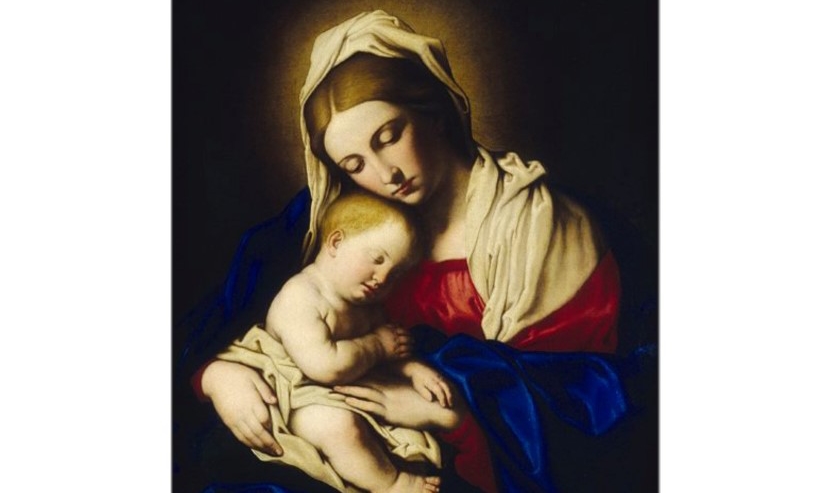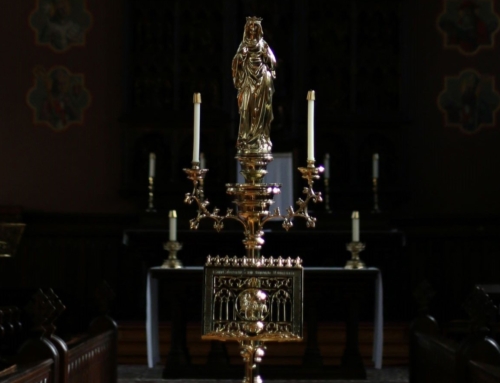Today is the memorial of St. Ambrose, bishop and doctor of the Church. He was born to an influential Roman family in 340 and eventually became a Roman Governor. He was made bishop of Milan in 374 at the behest of the populace, despite his fierce protestations, and became highly renowned. He defended Church doctrine from attacks, particularly from the Arians who denied the divinity of Christ. He also defended the divinity of the Holy Spirit and wrote much about Mary, the Mother of God. For all his writings, he was recognized a doctor (a great teacher) of the Church. During Advent, it is particularly opportune to consider his Mariology.
St. Ambrose penned an Advent hymn called Veni Redemptor Gentium (Come Redeemer of the Nations). In the second verse he describes the miraculous birth of Jesus:
Non ex virili semine,
sed mystico spiramine
Verbum Dei factum est caro
fructusque ventris floruit.
Literally, this means: “Not from man’s seed / But by the mystic spirit / The Word of God was made man / And the fruit of the womb sprung forth.” Spiramine, “spirit” also means “breath.” The breath of life once breathed into Adam is now breathed upon Mary. The Holy Spirit creates (On the Mysteries, 2.5). Unlike everyone else, Jesus is conceived by an act of God without bodily contact (On Virginity, II.2.7), just as the world was created without pre-existing matter. The incarnation is a sort of re-creation in the world, so that fallen nature may be redeemed. In the original creation, God made man in his own image. In the fullness of time, he created a body for himself. This meeting of heaven and earth, God’s complete gift of himself, happens in the womb of Mary.
The Holy Spirit is also the revealer. Ambrose tells us that the same cloud which led the Hebrews out of Egypt came to rest finally upon the Virgin Mary, in whom he conceived his son. (On the Mysteries, 3.13) This cloud that led the Hebrews over the Red Sea brought them to rest at Mount Sinai, where the law was revealed to Moses. This law was the fullest revelation of God up to that point in history. This is fulfilled in the Word of God, who is the New Law, conceived in Mary’s womb. The Holy Spirit reveals God to us in history through Mary.
Mary participates in a very special way in both creation and revelation by agreeing to bear the son of God. Before Mary conceived the God-man in her womb, however, she beheld him in prayer. In his work, On Virginity, Ambrose presents her as a model for consecrated virgins:
“She was a virgin not only in body but also in mind…humble in heart, grave in speech, prudent in mind, sparing of words, studious in reading, resting her hope not on uncertain riches, but on the prayer of the poor, intent on work, modest in discourse; wont to seek not man but God as the judge of her thoughts, to injure no one, to have goodwill towards all, to rise up before her elders, not to envy her equals, to avoid boastfulness, to follow reason, to love virtue.” (On Virginity, II.2.7)
Her soul was given entirely to prayer. When the Angel Gabriel came to announce to her the birth of Jesus, he found her alone, with nothing distracting her from her contemplation (On Virginity, II.2.10). Her contemplation continues after she gives birth. As Luke tells us, “Mary kept all these things in her heart.” (Lk 2:19, On Virginity, II.2.13)
We can learn from Mary’s habit of contemplation. We, too, are called to ponder in our hearts the mysteries revealed to us. During this season of Advent, as we prepare to commemorate the coming of the Redeemer of nations, it is opportune to take on small penances and remove distractions from our lives so that we can give ourselves especially over to prayer. But our contemplation must not only look backward. It prepares us for death, and our entry into our heavenly homeland, where together with Mary and Ambrose and all the angels and saints, we will contemplate the Holy Trinity for eternity.
✠
Image: Giovanni Battista Salvi, Madonna con il Bambino







